
Churches - Bevendean History Project

St Stephens Church, Montpelier PlaceSt
Stephen's Church in Montpelier Place, Brighton was founded on its
current site as a private chapel in 1822. It was dedicated as St
Stephen's Church on 25 July 1851 and consecrated on 11 June 1852.
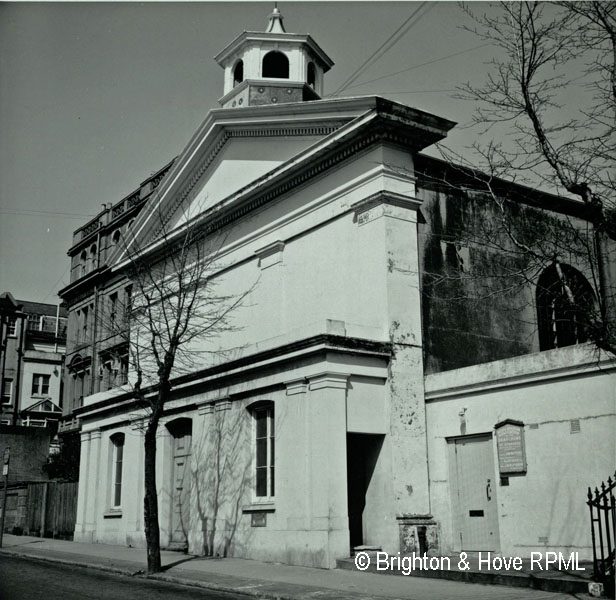
St Stephens Church front elevation in Montpelier Place.
Brighton began to develop as a spa town and seaside resort in the mid-18th century, encouraged by local doctor Richard Russell's influential advocacy of the therapeutic use of seawater, by drinking it and bathing in it. These activities became fashionable among high society and rich people, which gave the declining fishing village a surge of popularity in the 1750s.
The Steine (now Old Steine), an area of flat, grassy, sheltered land behind the seafront, developed as the growing town's promenade, where visitors would walk and socialise. The surrounding area soon became built up, and in 1752 innkeeper Samuel Shergold bought a recently built house on the southwest side of The Steine and converted it into a tavern with assembly rooms. The venue, called the Castle Inn or Castle Tavern, became increasingly popular, and in 1766 John Crunden designed an extension on the north side of the inn. This extension housed a 450 capacity, 24 m by 12 m ballroom. For the next half-century, it was one of the most popular social venues in the town, rivalled only by the Old Ship Inn and assembly rooms whose owner cooperated with Shergold to provide a regular programme of alternating social events. Contemporary accounts described the Castle Inn's ballroom and assembly rooms as some of the best and most architecturally impressive in England.
Decline set in during the early 19th century, and the assembly room's first summer-season closure occurred in 1815. Crunden's ballroom had closed the previous year. In 1815, Shergold offered a 25% share in the building and its land, and the Prince Regent, later King George IV, bought it through an intermediary, Thomas Attree, for £1,960 (£154,400 in 2023).
He acquired another 25% share in 1816 and the remaining 50% in 1822, and the inn closed to the public soon afterwards and was demolished in stages between 1819 and October 1823.
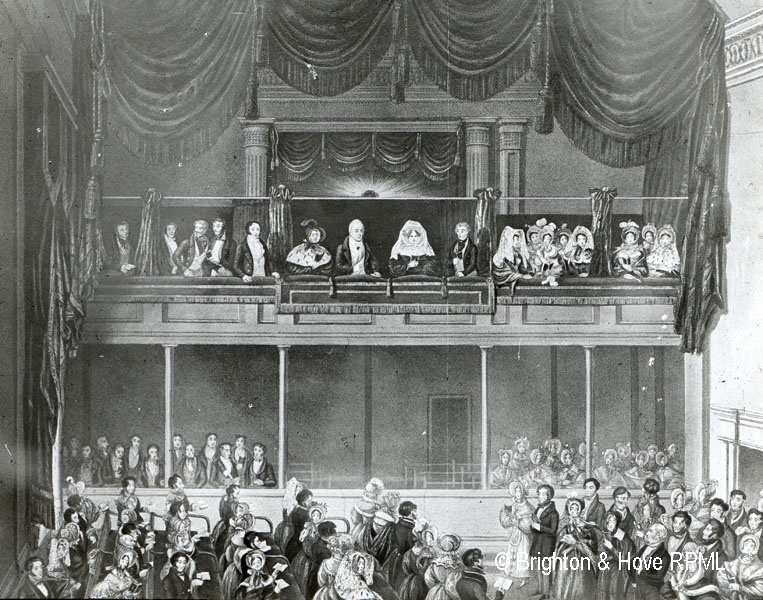
An illustration of the Chapel Royal now St Stephens Montpelier Place.
The ballroom was converted into the recently completed Royal Pavilion's private chapel for the Prince Regent, who by this time was King, and was consecrated on 1 January 1822 by the Bishop of Chichester. The King had moved into the Pavilion the previous year. In its new guise, the chapel had over 400 seats and admission was by invitation only. Designer William Tuppen was responsible for the interior refit, which included the conversion of the musicians' gallery into the King's own pew and the installation of an organ supported by Gothic-style columns.
The Royal Pavilion was unpopular with Queen Victoria, whose reign began in 1837. Her last visit was in 1845; soon afterwards the Government wanted to demolish the building and sell the land to pay for building work at Buckingham Palace. This proposal was unpopular in the town, and in May 1850 the Town Commissioners received consent to buy the 9-acre site, including the chapel. It became the property of Brighton Corporation in 1855.
Because the chapel had been consecrated for Anglican worship, the Church Commissioners claimed it on behalf of the Diocese of Chichester. Instead of leaving the building on the same site, the Diocese decided to demolish it and re-erect it brick by brick on a site 1 mile away, at Montpelier Place near the boundary with Hove. The land at Montpelier Place was transferred free of charge to the Diocese by the Vicar of Brighton's sister.
The interior of the chapel was only minimally altered by the move and reconstruction, which was completed in 1851. It was given a new stuccoed façade in the Classical style.
The pedimented street front and lantern, but not the broad, single storey porch are of that date, by Cheeseman; and the church was remodelled by Arthur Blomfield in 1889. The main front is divided into 3 bays by single Doric pilasters; there is a single-storey extension to the east of the original building with flat arched entrance.
The interior is in the Adam style and consists of a single principal space, the walls articulated with pilasters whose faces are decorated with griffins, urns, palmettes and repeating calyx forms, with palm-leaf capitals; the central portion of each wall is recessed with an arrangement of pilasters and columns, similarly detailed, distyle in antis; entablature with frieze of urns enclosed in ovals, missing at the south-west corner; segmental-arched ceiling with 3 large roses of acanthus ornament.
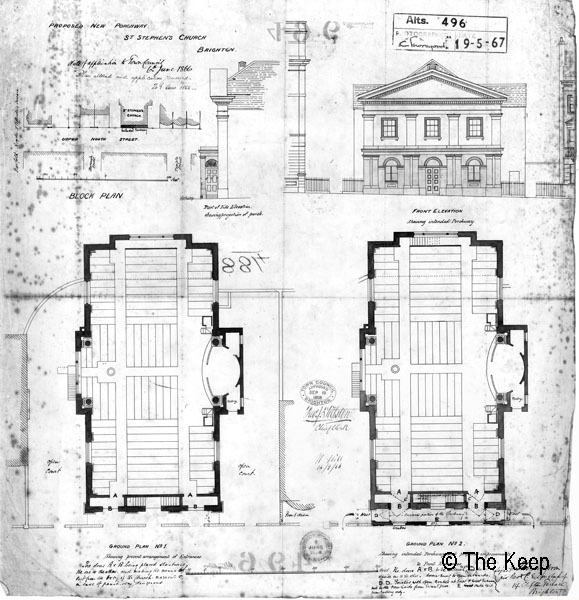
Plans of St Stephens Church date June 1865 when a new porchway was proposed on the front of the building.
The church was opened for public worship under its new name, St Stephen's, on 25 July 1851, and was consecrated on 11 June 1852 by the Bishop of Chichester, the Right Reverend Ashurst Turner Gilbert. The Vicar of Brighton's nephew George Wagner became its first vicar. The church could hold more than 700 worshippers, and approximately one-quarter of the pews were free, that is not subject to pew rents. It attracted a mostly poor congregation.
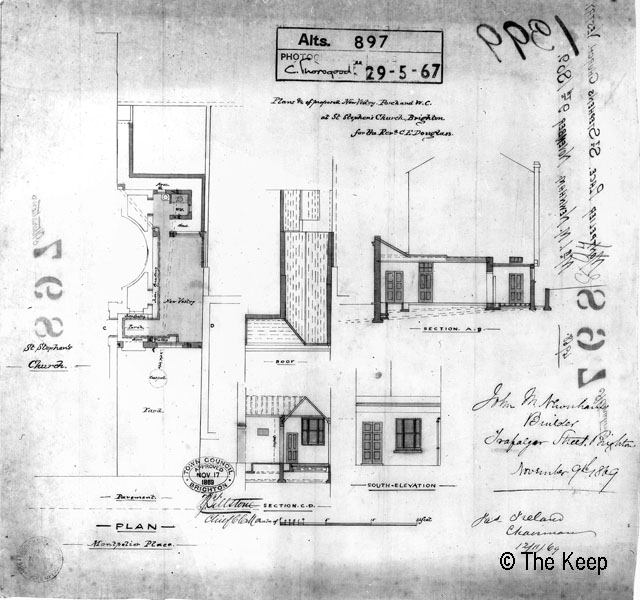
Plans for a new vestry dated November 1869.
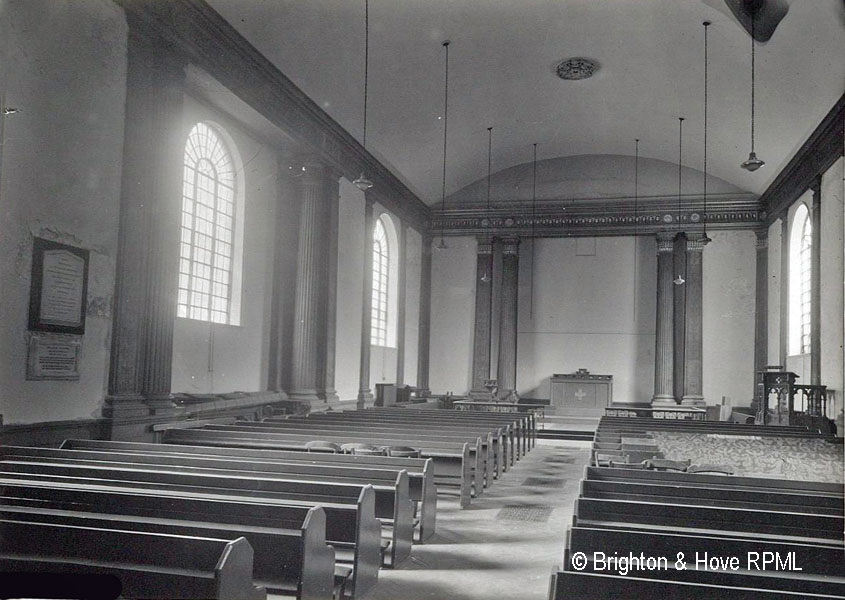
St Stephens interior view towards the sanctuary c1950.
Some internal changes were made over the next 90 years, but the Rev. Charles Douglas's plans for a new Byzantine-style church on the site, announced in the 1860s, were not realised. A porch and vestry were built in 1868, and a new lectern, altar rails, organ and pulpits were put in. Arthur Blomfield carried out further renovation work in 1889. In the 1930s the church became associated with The Anglican Diocese of Chichester's Healing Ministry, under the leadership of the Revd. John Maillard, and it was closed in 1939 and converted into the Diocese of Chichester's Institute for the Deaf and Dumb.
St Stephens Centenary in 1951
St. Stephens Church celebrated its centenary on Wednesday the 25th July 1951. A series of services were held starting on Sunday 22 July at 7.30 p.m. when the preacher was Canon W. Godfrey Bell, chairman of the Sussex Diocesan Association for the Deaf and Dumb.
The Vicar of Brighton (Canon F. N. Robathan, O.B.E.) preached at a Mothers' Union service on Monday 23rd in the afternoon, at 3.30, when a new banner was dedicated; and on the Wednesday 25th, at 7.30, the centenary service was conducted by the Rev. H. H. Tarrant, Vicar of Haywards Heath.
The celebrations concluded on Sunday, July 29, when the Bishop of Lewes, the Rt. Rev. Geoffrey H. Warde, preached at the evening service at 6.30 p.m.
From: The Brighton Herald on 21st July 1951
When St. Stephen's was converted as a Centre for the Deaf in 1939, a number of features were incorporated: —
The lighting consisted of special diffused lamps of 500 watt at a height of 20 ft. in an attempt to give a powerful overall light making it easy for the Deaf to see.
The Altar and Sanctuary were well lit ensuring again easy reading of the lips and hands by all in the congregation. The compact feature of the Church allowed all the congregation to be as near to the Sanctuary as possible, so as to give as clear a vision as possible.
A green background was used behind the Altar and on the Stage, to give a restful background.
The Stage was well lit and Television was installed.
The main section of the Hall was furnished with plenty of easy chairs and occasional tables.
The canteen was provided with the latest tables and chairs giving a clean and pleasing appearance.
In 1974, the Institute for the Deaf and Dumb moved to a building next to the former St John the Evangelist's Church on Carlton Hill.
In 1988, a local housing association acquired the building and converted it into the First Base Day Centre for homeless people.
Crunden's interior, which had survived largely intact since he built the ballroom in 1766, was damaged by fire soon after the day centre opened, but has been restored.
The building in the 21st century
St Stephen's Church was listed at Grade II* by English Heritage on 13 October 1952. This status is given to "particularly important buildings of more than special interest". As of February 2001, it was one of 70 Grade II* listed buildings and structures, and 1,218 listed buildings of all grades, in the city of Brighton and Hove.
The First Base Day Centre, as the building is now known, is run by Brighton Housing Trust. It was established in the 1960s and now has several sites in the city. About 100 people use the centre daily. Since the trust acquired the building, it has made several internal alterations.
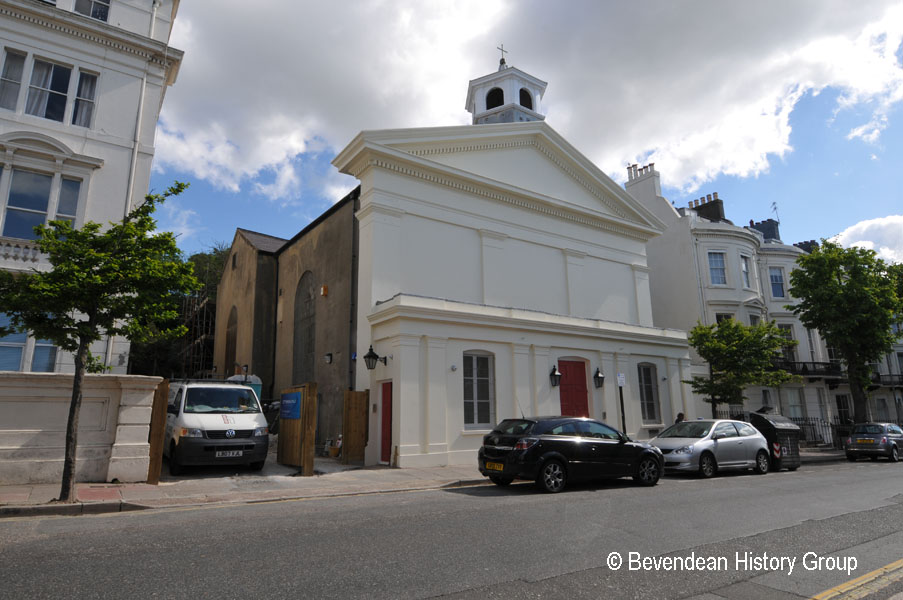
The former St Stephen Church in 2011.
A plaque on the outside of the building has the following inscription.
‘THIS BUILDING WHICH ORIGINALLY STOOD IN CASTLE SQUARE WAS DESIGNED BY JOHN CRUNDEN IN 1766 AS THE BALL ROOM OF THE CASTLE TAVERN BECAME THE CHAPEL OF THE ROYAL PAVILION IN 1822 AND WAS MOVED TO THIS SITE IN 1852’.
Erected by the Regency Society
More Photographs coming soon

St Stephens Church front elevation in Montpelier Place.
Brighton began to develop as a spa town and seaside resort in the mid-18th century, encouraged by local doctor Richard Russell's influential advocacy of the therapeutic use of seawater, by drinking it and bathing in it. These activities became fashionable among high society and rich people, which gave the declining fishing village a surge of popularity in the 1750s.
The Steine (now Old Steine), an area of flat, grassy, sheltered land behind the seafront, developed as the growing town's promenade, where visitors would walk and socialise. The surrounding area soon became built up, and in 1752 innkeeper Samuel Shergold bought a recently built house on the southwest side of The Steine and converted it into a tavern with assembly rooms. The venue, called the Castle Inn or Castle Tavern, became increasingly popular, and in 1766 John Crunden designed an extension on the north side of the inn. This extension housed a 450 capacity, 24 m by 12 m ballroom. For the next half-century, it was one of the most popular social venues in the town, rivalled only by the Old Ship Inn and assembly rooms whose owner cooperated with Shergold to provide a regular programme of alternating social events. Contemporary accounts described the Castle Inn's ballroom and assembly rooms as some of the best and most architecturally impressive in England.
Decline set in during the early 19th century, and the assembly room's first summer-season closure occurred in 1815. Crunden's ballroom had closed the previous year. In 1815, Shergold offered a 25% share in the building and its land, and the Prince Regent, later King George IV, bought it through an intermediary, Thomas Attree, for £1,960 (£154,400 in 2023).
He acquired another 25% share in 1816 and the remaining 50% in 1822, and the inn closed to the public soon afterwards and was demolished in stages between 1819 and October 1823.

An illustration of the Chapel Royal now St Stephens Montpelier Place.
The ballroom was converted into the recently completed Royal Pavilion's private chapel for the Prince Regent, who by this time was King, and was consecrated on 1 January 1822 by the Bishop of Chichester. The King had moved into the Pavilion the previous year. In its new guise, the chapel had over 400 seats and admission was by invitation only. Designer William Tuppen was responsible for the interior refit, which included the conversion of the musicians' gallery into the King's own pew and the installation of an organ supported by Gothic-style columns.
The Royal Pavilion was unpopular with Queen Victoria, whose reign began in 1837. Her last visit was in 1845; soon afterwards the Government wanted to demolish the building and sell the land to pay for building work at Buckingham Palace. This proposal was unpopular in the town, and in May 1850 the Town Commissioners received consent to buy the 9-acre site, including the chapel. It became the property of Brighton Corporation in 1855.
Because the chapel had been consecrated for Anglican worship, the Church Commissioners claimed it on behalf of the Diocese of Chichester. Instead of leaving the building on the same site, the Diocese decided to demolish it and re-erect it brick by brick on a site 1 mile away, at Montpelier Place near the boundary with Hove. The land at Montpelier Place was transferred free of charge to the Diocese by the Vicar of Brighton's sister.
The interior of the chapel was only minimally altered by the move and reconstruction, which was completed in 1851. It was given a new stuccoed façade in the Classical style.
The pedimented street front and lantern, but not the broad, single storey porch are of that date, by Cheeseman; and the church was remodelled by Arthur Blomfield in 1889. The main front is divided into 3 bays by single Doric pilasters; there is a single-storey extension to the east of the original building with flat arched entrance.
The interior is in the Adam style and consists of a single principal space, the walls articulated with pilasters whose faces are decorated with griffins, urns, palmettes and repeating calyx forms, with palm-leaf capitals; the central portion of each wall is recessed with an arrangement of pilasters and columns, similarly detailed, distyle in antis; entablature with frieze of urns enclosed in ovals, missing at the south-west corner; segmental-arched ceiling with 3 large roses of acanthus ornament.

Plans of St Stephens Church date June 1865 when a new porchway was proposed on the front of the building.
The church was opened for public worship under its new name, St Stephen's, on 25 July 1851, and was consecrated on 11 June 1852 by the Bishop of Chichester, the Right Reverend Ashurst Turner Gilbert. The Vicar of Brighton's nephew George Wagner became its first vicar. The church could hold more than 700 worshippers, and approximately one-quarter of the pews were free, that is not subject to pew rents. It attracted a mostly poor congregation.

Plans for a new vestry dated November 1869.

St Stephens interior view towards the sanctuary c1950.
Some internal changes were made over the next 90 years, but the Rev. Charles Douglas's plans for a new Byzantine-style church on the site, announced in the 1860s, were not realised. A porch and vestry were built in 1868, and a new lectern, altar rails, organ and pulpits were put in. Arthur Blomfield carried out further renovation work in 1889. In the 1930s the church became associated with The Anglican Diocese of Chichester's Healing Ministry, under the leadership of the Revd. John Maillard, and it was closed in 1939 and converted into the Diocese of Chichester's Institute for the Deaf and Dumb.
St Stephens Centenary in 1951
St. Stephens Church celebrated its centenary on Wednesday the 25th July 1951. A series of services were held starting on Sunday 22 July at 7.30 p.m. when the preacher was Canon W. Godfrey Bell, chairman of the Sussex Diocesan Association for the Deaf and Dumb.
The Vicar of Brighton (Canon F. N. Robathan, O.B.E.) preached at a Mothers' Union service on Monday 23rd in the afternoon, at 3.30, when a new banner was dedicated; and on the Wednesday 25th, at 7.30, the centenary service was conducted by the Rev. H. H. Tarrant, Vicar of Haywards Heath.
The celebrations concluded on Sunday, July 29, when the Bishop of Lewes, the Rt. Rev. Geoffrey H. Warde, preached at the evening service at 6.30 p.m.
From: The Brighton Herald on 21st July 1951
When St. Stephen's was converted as a Centre for the Deaf in 1939, a number of features were incorporated: —
The lighting consisted of special diffused lamps of 500 watt at a height of 20 ft. in an attempt to give a powerful overall light making it easy for the Deaf to see.
The Altar and Sanctuary were well lit ensuring again easy reading of the lips and hands by all in the congregation. The compact feature of the Church allowed all the congregation to be as near to the Sanctuary as possible, so as to give as clear a vision as possible.
A green background was used behind the Altar and on the Stage, to give a restful background.
The Stage was well lit and Television was installed.
The main section of the Hall was furnished with plenty of easy chairs and occasional tables.
The canteen was provided with the latest tables and chairs giving a clean and pleasing appearance.
In 1974, the Institute for the Deaf and Dumb moved to a building next to the former St John the Evangelist's Church on Carlton Hill.
In 1988, a local housing association acquired the building and converted it into the First Base Day Centre for homeless people.
Crunden's interior, which had survived largely intact since he built the ballroom in 1766, was damaged by fire soon after the day centre opened, but has been restored.
The building in the 21st century
St Stephen's Church was listed at Grade II* by English Heritage on 13 October 1952. This status is given to "particularly important buildings of more than special interest". As of February 2001, it was one of 70 Grade II* listed buildings and structures, and 1,218 listed buildings of all grades, in the city of Brighton and Hove.
The First Base Day Centre, as the building is now known, is run by Brighton Housing Trust. It was established in the 1960s and now has several sites in the city. About 100 people use the centre daily. Since the trust acquired the building, it has made several internal alterations.

The former St Stephen Church in 2011.
A plaque on the outside of the building has the following inscription.
‘THIS BUILDING WHICH ORIGINALLY STOOD IN CASTLE SQUARE WAS DESIGNED BY JOHN CRUNDEN IN 1766 AS THE BALL ROOM OF THE CASTLE TAVERN BECAME THE CHAPEL OF THE ROYAL PAVILION IN 1822 AND WAS MOVED TO THIS SITE IN 1852’.
Erected by the Regency Society
More Photographs coming soon
